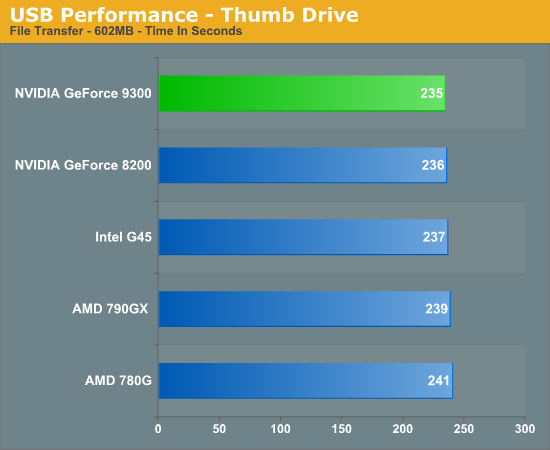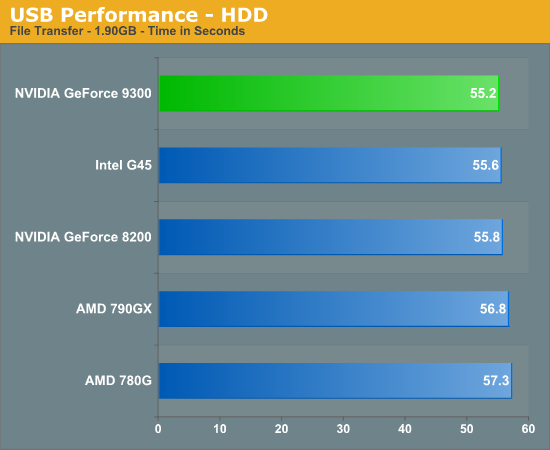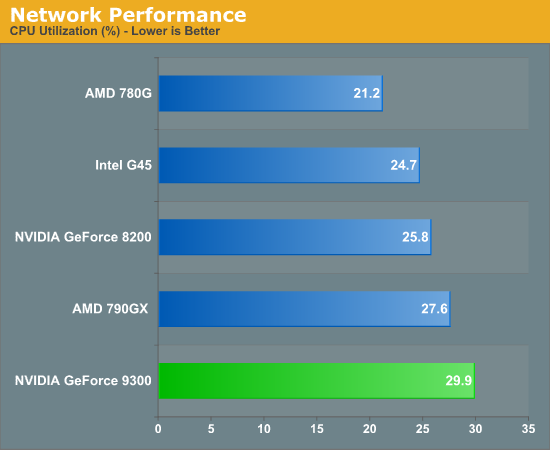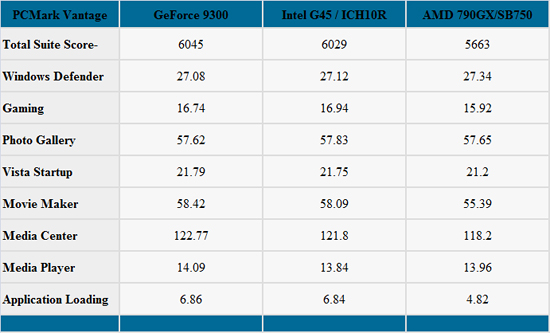The IGP Chronicles Part 3: NVIDIA's GeForce 9300
by Anand Lal Shimpi & Gary Key on October 15, 2008 12:00 AM EST- Posted in
- Motherboards
USB, Networking and Storage Performance
Our USB transfer speed tests were conducted with an OCZ Rally 2 Turbo 4GB Flash Drive and USB 2.0/FireWire based Maxtor OneTouch II external hard drive. In our first test, we transfer a 602MB file folder containing 444 files of various sizes. In our second test, we transfer a 1.90GB file folder containing 17 different files.
USB Performance


NVIDIA chipsets have always performed well in our USB tests and once again hold a slight edge over the Intel and AMD offerings. The improved USB performance from the AMD SB700/750 Southbridges almost close the gap with the NVIDIA and Intel offerings.
Ethernet Performance
The current motherboard test suite includes LAN performance measurements. All of these boards utilize PCI or PCI Express based Gigabit controllers with the only difference being the supplier of the core logic. The Windows 2000 Driver Development Kit (DDK) includes a useful LAN testing utility called NTttcp. We used the NTttcp tool to test Ethernet throughput and the CPU utilization of the various Ethernet Controllers used on the Intel motherboards.
We set up one machine as the server; in this test, an Intel system with an Intel CSA Gigabit LAN connection. Intel CSA has a reputation for providing fast throughput and is a logical choice for our Gigabit LAN server.
On the server side, we used the following Command Line as suggested by the VIA whitepaper on LAN testing:
Ntttcpr -m 4,0,‹server IP› -a 4 -l 256000 -n 30000
On the client side (the motherboard under test), we used the following Command Line:
Ntttcps -m 4,0,‹client IP› -a 4 -l 256000 -n 30000
At the conclusion of the test, we captured the throughput and CPU utilization figures from the client screen.


Our network throughput test indicates how well a particular controller design from Realtek, Marvell, NVIDIA, or Intel performs instead of being indicative of true chipset performance. This also holds true for the CPU utilization results, though this test can also be influenced to certain degree by the BIOS code and chipset interconnect design.
PCMark Vantage
PCMark Vantage is the latest benchmark available from Futuremark, and it is only for use with Windows Vista. Similar to the venerable PCMark05 in its makeup, Vantage modernizes the criteria and test methodology to reflect what users may encounter when running the new Windows OS and current applications. The total benchmark is roughly 87% reads and 13% writes in nature. We run each test five times per drive, producing a median score that we use for comparison in our charts. We utilize AHCI settings for each board.

NVIDIA chipsets generally provide excellent performance, albeit at the cost of stability at times, and our tests reveal a controller that is slightly better in performance than the Intel ICH10R. Really, it is a toss-up between the two controllers. The AMD SB750 trails slightly due to an AHCI implementation that is not as robust as the current NVIDIA or Intel offerings. However, it would be very difficult to discern any performance differences between these controllers in actual application work.
As we noted earlier, we had a few issues with AHCI settings and our Sony BDU-X10S BD drive along with some random slowdowns when transferring large amounts of data (Update- Latest BIOS/Firmware/Drives solved this problem). We have not and do not expect to notice any data corruption problems that crept up during the 780i/790i launch, which were eventually fixed by NVIDIA. Our Intel G45 board also had difficulties with the same Sony BD drive but the AMD SB700/750 have not been affected.










47 Comments
View All Comments
XavierJohn - Thursday, October 23, 2008 - link
I switched from a Pioneer Elite to Integra DHC-9.9 and to me it seems like the Pioneer sounds better. Pioneer during its speaker setup also setup EQ to compensate for room modes. I did not see Integra do that.XavierJohn - Friday, October 17, 2008 - link
I wish you said atleast one sentence on why you would go from Pioneer to DTC 9.8.Better sound?
BikeDude - Thursday, October 16, 2008 - link
I have never fully understood "PureVideo". It is my understanding that this is only supported by a handful few players, like the awfully buggy PowerDVD that simply won't run on my system (PowerDVD no longer support SCSI DVD-ROM).Atechie - Friday, October 17, 2008 - link
Funny, Windows Media Player and PureVideo works fine for me?iwodo - Thursday, October 16, 2008 - link
The performance for Ethernet CPU usage seems rather poor. In fact all of them are bad, as Intel should be in the region of single digit percentage shown in other website.One interesting point i realize while reading, i hope to share with their reader.
Is that measuring the few percentage difference with low CPU resoource usage playing H.264 Full HD isn't very important at all... Why?
Because the difference between 15 - 25% , while 10% looks like a lot, the most important factor is POWER CONSUMPTION. While most people would think lower CPU usage and therefore lower power usage. In this article it turns out while Geforce has the lowest power consumption while using most CPU resources.
And how many people use their CPU for other heavy task while watching Full HD Movie?
I cant wait to see these being refreshed next summer, with 40nm, more die space because memory and most northbridge move to CPU, we should be able to put more then double the shader inside?
crabnebula - Wednesday, October 15, 2008 - link
I know the focus is on Blu-ray and progressive source material, but most people stil have SD DVDs and 1080i TV broadcasts that they want to play back on their HTPC.Adequate deinterlacing, detail enhancement and noise reduction have been the missing pieces of the puzzle for all other IGPs except the 780G + Phenom combination, but that has other issues.
What about the 9300/9400? Does the increased GPU power allow for better processing?
If it doesn't, there is one other check missing on your list, in my opinion.
Natfly - Wednesday, October 15, 2008 - link
So is this the article that was supposed to come out analyzing the 780G, 8200, and G45? You know, months.... and months.... and months ago? I'm glad you guys waited until nVidia released a competative product before releasing this article. Otherwise I would have bought a 780G motherboard months ago.AmdInside - Wednesday, October 15, 2008 - link
I wish you guys wouldn't use the Sony BDU-X10S in your testing. I've owned this drive and it just sucks. Had problems on both Intel and NVIDIA chipsets.As for the data transferring problem, I had the same problem recently on my Badaxe2 motherboard. I was moving my hard drive from my Geforce 8200 system to Intel G45 system but first needed to copy recordings to another hard drive so that I could format the hard drive. My desktop has a Badaxe2 is running Vista x64 and I too randomly experienced pauses when copying 500GB of data. Not sure if it is related but it might just be a Vista thing.
Badkarma - Wednesday, October 15, 2008 - link
Hi Anand/Gary,In your next installment, can you please find the slowest usable CPU that plays Bluray smoothly and also test Speedstep with it? Using a quadcore is really overkill and kind of defeats the purpose of GPU DXVA. The 8200 w/ a 4850e cannot utilize CnQ to playback BR. I'd like to see whether a 9300 w/ E5200 or E7200 and Speedstep enabled can play BR smoothly.
Thanks.
sonicology - Wednesday, October 15, 2008 - link
Nice LL Cool J reference in the article description!